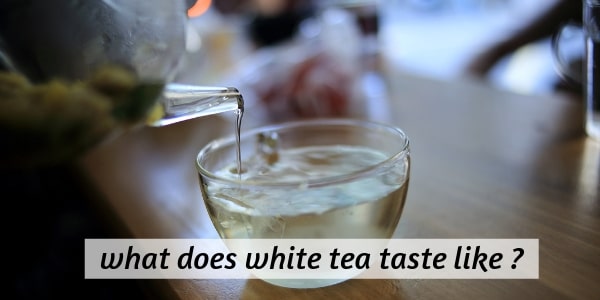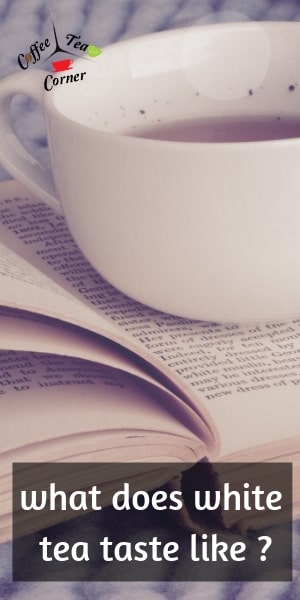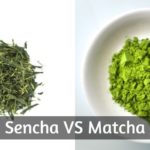If you're considering taking up white tea, you might want to know what it tastes like beforehand. I understand that, and white tea really is a more delicate tea than others.
As such its taste and brew method is going to be a bit different from what you're used to with other teas. So let's talk about what white tea tastes like, and how to make a great cup of white tea.

Table of Contents
So what does white tea taste like ?
Often white tea is described as a sweeter kind of tea (compared to green or black), with floral notes that can also include vanilla, honey, fruity, rose, melon and sometimes ginger.
Its flavor is subtle and delicate, it will not be as strong as other teas.
White tea is a much lighter tea than green tea, and less bitter. It comes from the same tea plant, but it's made from the young buds and shoots of the plant.
If you've a beginner in tea tasting and have had many strong drinks like coffee or soda, white tea might taste very faint to you at first. In truth, this delicate tea will taste almost bland for those who don't have their taste buds trained to notice slight differences.
So let's talk about why white tea is such a delicate tea, and how you can enjoy it best.
White tea is a delicate, floral type of tea
White tea is made from the same plant as the green or black tea we usually find on the market. For green tea the young leaves are used, for black tea the slightly older leaves are used, but they are processed for longer than green tea leaves.
As for white tea, we need only the youngest, most tender buds and shoots from the Camellia sinensis plant. This means that the leaves are picked earlier in the year, compared to green tea.
The very young leaves still have some fine, white hairs on them, and that is where the name of white tea happens to come from as well.
So a large part of the white tea's delicate taste comes from the fact that it's made of very delicate buds to begin with. Another reason is the fact that this tea is processed differently than green and black teas.
Where a green or black would be pan-seared or over baked, a white tea is simply left to dry in the sun on its own. This preserves the delicate taste of the buds.
Depending on where the tea farm is located, and in which year the tea was picked, you might end up with a different white tea. As in a white tea picked in China in the beginning of 2018 might be different from a Ceylon (Sri Lanka) white tea picked in Spring 2014.
There is the difference in terrain and climate between China and Sri Lanka that can influence the taste of the final tea. And then there are the special conditions that have affected the climate in each year, sometimes producing a sweeter tea, sometimes a more floral one without being necessarily sweet.
Again, please remember than if you're not used to delicate notes in your tea, then white tea might be too delicate for you and simply taste watery or bland.
There is also the steeping times that you need to take into account, and we'll cover that in this article as well. For now, you should know that you can easily ruin a perfectly delicate white tea by scalding it and it will be come a very bitter and dark tea.
(If you like this article so far, you can pin it to your Pinterest board by clicking the image below. The article continues after the image.)
White tea has more caffeine than green or black tea
When it comes to caffeine content, white tea seems to be the winner here. Compared to green tea and black tea, which use fully grown leaves, white tea has much more caffeine.
This is because the spear and shoots of the tea plant are the ones with the most caffeine in them. This is what helps them grow a bit quicker, and keeps insects and pests away.
For example black teas made with a few spears in them, or even with half of their content being spears contain much more caffeine than the usual black teas.
So if you're using white tea for the health benefits, you're also getting more of a caffeine kick from it than you usually do from black or green tea. It also has to do with how much the leaves of the tea were roasted.
Seeing as white tea is not roasted but simply left to dry, the caffeine content in them is the same as when they were picked. This drying process also affects the various nutrients and vitamins present in the tea leaf buds.
So as a whole, white tea is even healthier than your usual cup of green tea. Something to keep in mind when looking for health drinks.
Of course, white tea, like green tea, can be enjoyed cold as an iced tea as well. Just make sure to never freeze white tea (be it brewed or loose leaves) since you are ruining the taste of your future tea and the texture of the leaves.
An example of a good white tea
When looking for a white tea you should be looking for a delicate tea, and a loose leaf one if possible. Do take into account that most white teas will not look white. Neither the leaves themselves, or the resulting infusion will be white.
Rather you should look for the remainder of fine white hairs on the small leaves of buds. In some teas like the Baihao Yinzhen only the buds of the tea plant are used, and you might notice some fine hairs floating in your tea as you drink it. These hairs are alright for humans, nothing bad will happen.
Another thing to look out of is the color of the brew itself. Often it will be a light, pale yellow color. It might smell floral, it might resemble honey, and it will be slightly vegetal but not enough to be bothersome.
For example this white tea is a silver needle one. This tea is in a longer shape than other white teas, and silver needles are among the best kinds of white tea available for purchase.
Remember to use an infuser to brew your loose leaf tea, or strain it if you make it in a pot. Always try and let your leaves have lots of space to expand and unfurl, so they can release all their flavor.
Just remember that these aren't leaves as much as they are buds, so they might expand but not too much.
You can check the listing on Amazon here, and read the reviews as well.
Brewing white tea the right way
When you do start to brew your white tea, you should be mindful of a couple of things. First, the white tea is a very delicate tea and requires cooler water and a black or green tea.
Actually it needs water around 75 C/167 F and a longer steeping time. You can start with one full minute, and taste the tea with a teaspoon. Leave the tea for longer if you're unhappy with it, tasting it every 30 seconds or so, until you find your perfect brewing time.
In some cases you might need to let the tea sit for even 10 minutes, if it's a very delicate one. At any rate, better to steep white tea at a low temp for a longer time than a higher temp for a shorter time.
White tea is very delicate, and you risk scalding it if you steep it in water hot enough for black tea, for example. Seeing as white tea withstands a longer brewing time, you can also use it to make an iced tea with the cold brew method.
You can reuse white tea leaves, yes, just be aware than you will need a much longer steeping time and slightly hotter water. The resulting infusion will be weaker than the first cup, so in some cases it might not be worth it. Still, you can try and see if you like the second cup.
But if you're making hot brew tea, then it would be wise to heat up your cup of tea beforehand. This is because white tea will taste different if put in a cold cup, because it will lower the overall temperature of the infusion.
Keep in mind that white tea is fluffier and lighter in texture than other teas. So you might need to add more tea than you might think at first for a whole cup.
Start out with 2 teaspoons of tea for 8 ounces/226 ml of water as your baseline, and adjust from there according to how you like your tea.
White tea is meant to be enjoyed in its own, without any added flavors or sweeteners. But if you want, you can add honeycomb as a sweet and healthy pick me up to your very healthy white tea.
Final thoughts
When it comes to white tea not many people know what it is and how to drink it. I didn't either until I explored the tea houses in my college city and stumbled across white tea.
I was wary at first, actually for a few years, thinking it would be a very odd tea and I'd enjoy a green one more. In truth, I had a beautiful White Peony as my first white tea and I enjoyed it.
But this was only after I'd developed a good eye (or taste bud ?) for quality tea and went through cups and cups of green and black tea from the same tea house.
If you're curious about white tea, I strongly recommend you try it at least once. Keep an open mind and remember that this really is a delicate tea.
Serve it with something sweet next to it, and your tea will be lost. Best to enjoy it on its own, maybe next to a salted snack rather than a sweet one.
If you want to know more about coffee or tea, feel free to check the related articles below. Who knows what else you might find ?






